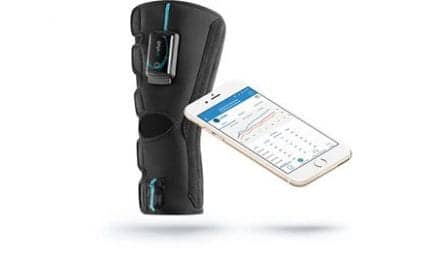Technology can aid therapists in creating reflex training drills to improve clients’ reaction times, balance, proprioception, and overall performance.
By Kevin Wilk, PT, DPT, FAPTA
Reflex training, or reaction training, has long been a critical component of a physical therapy program for patients of all kinds—from injured athletes who want to return to sport to elderly adults who rely on their reflexes to prevent falls and other accidents.
A reflex is an unconscious response to the world around us, often triggered to protect us from danger. It is an athlete’s reflexes that stabilize them while they complete a complex movement on the field or make them put out an arm to break a fall. Reflexes are a central component of the physical movements we make daily, whether it’s preventing ourselves from stumbling or getting out of the way of an object careening toward us.
Having efficient reflexes is very important. Therefore, it is critical to incorporate reaction training strategies during the rehabilitation process. It is not sufficient enough to only train tissues and joints. The nervous system also needs the same consideration. Physical therapists use a variety of modalities to train the nervous system based on each patient’s needs. These might include standing on a balance board, catching a ball, or completing an agility ladder drill.
While all these exercises are effective, physical therapists now also have access to technologically advanced tools to improve patients’ reaction times, proprioception, balance, and overall performance. I implemented one such tool in my practice two years ago with great success: the BlazePod, from the Tel Aviv, Israel-based company of the same name. It has proven to be very versatile and motivational for many of my patients.
Flash Reflex Training
BlazePod has developed a training methodology called Flash Reflex Training, which uses LED light-up pods to create a stimulus for patients to test their reflexes and improve their reaction time. The product can be purchased with between four and 12 pods that are integrated into a mobile app with hundreds of sport- and goal-specific drills. The pods light up at different times and with up to eight different light colors to create these varied drills.
The pro membership version of the product, BlazePod Pro, allows me to customize, save, and share drills, so that my patients can do their specifically tailored program with me at the clinic or at home on their own. The seemingly endless configurations on the BlazePod app allow me to create effective, novel, and motivating exercises for them using these small round pods with sequenced flashing lights. They love the challenge, the gamification, and the results that they are getting. It has been great to share new drills with them while they continue their therapy at home after our in-office treatment plan is complete.
Using this technology, my patients are recovering from injury and improving their performance in less time. One of the reasons why is because this type of system is engaging and encourages them to create new neuropathways by challenging their central nervous system (brain, etc) while triggering a physical movement.
Dual Tasking
We are seeing more research dedicated to the neurocognitive aspect of injury rehabilitation and injury prevention which affects the patient’s ability to recognize, react, and move effectively. We’ve learned that after many injuries—such as an ankle sprain, ACL tear, or shoulder injury—there’s a percentage of people whose central nervous system, due to neuroplasticity, develops an altered perception and reaction that prevents someone from contracting their muscle and moving the way they were able to prior to an injury.1 These altered movement patterns are abnormal and detrimental, and they prolong the rehabilitation process. They may also contribute to reinjury.
Having patients complete exercises in which they are forced to dual task, which is a key component of my drills, is one way to remedy this. This process of completing two tasks at once can override the neuroplasticity that is hindering their movement and reduce the effects of the injury.
With traditional methods, we might achieve this by having a patient stand on a balance board while throwing a ball. And I still incorporate these exercises into my practice as a complement to newer technology. Fitterfirst, Alberta, Canada, sells a wide range of balance boards to meet patients’ needs, while Stretchwell, Warminster, Pa, is an example of a company that sells different fitness balls and medicine balls that can be used for this purpose and many other exercises. But with a system like BlazePod, you can further enhance a session with additional options for this kind of therapy that offer more complexity and variety.
Dual Task Drills
For example, a patient with a knee injury could improve balance and stability by standing on one leg while using their opposite hand to tap the pods as they light up. This creates a mental task for the patient while their leg is forced to keep them steady.
We might also have the patient complete a BlazePod drill while catching a ball, kicking a ball through a soccer net, or verbally counting. We bombard their central nervous system with stimulus and find that when patients are so focused on reacting to the lights and hitting the target, they lose some inhibition that allows them to move more effectively.
As another example, for someone with a lateral ankle sprain—which can become chronic with several sprains—we can create a drill where they are moving laterally while being cognizant that they have to stabilize the ankle so that it doesn’t turn out and become susceptible to injury. We start at a slow pace, then work our way up to a faster pace as the client builds their stability and control. This ultimately helps minimize their chance of re-injury, even if this has been an ongoing problem for them.
We are also seeing the benefits of this form of reaction training and dynamic stabilization for people with hypermobility, a history of sprains, and very loose joints.
Tracking Progress and Movement
An additional benefit of BlazePod is that I can use the mobile app to track each client’s progress with specific drills—showing the speed at which they are completing exercises down to the millisecond. This allows me to better tailor the client’s program and allows the patient to see how they are progressing and improving over time, which can be extremely motivating.
In addition to monitoring the patient’s reaction time, using BlazePod allows me to focus on how patients are completing the exercise to ensure they are moving in an optimal way so I can provide feedback throughout the drill to correct any movement issues.
These benefits also help me to improve patient compliance, which is incredibly important during a rehabilitation program. I can engage clients more fully because they are having fun and enjoying the process. This encourages patients to push themselves more during our sessions while increasing the likelihood they will complete their physical therapy program and make a full recovery while avoiding reinjury.
Creating a Challenge
Rehab is often not fun for patients. It can be slow, repetitious, and boring. But when I incorporate gamified technology, my clients enjoy their sessions more and it improves patient retention. I even create competitions among patients by having a whiteboard in my office where we post high scores. I find that with this new addition patients are very motivated to beat their own high score, compete against someone else, or compare themselves to a pro athlete.
Because of this, I like to use a product like this from the time a patient first comes to see me following an injury or surgery all the way to the finish line. Even doing something as simple as a straight leg raise can become more impactful and challenging when we add reaction training movements, such as the client tapping a pod with their hands.
Continuing to find new ways to incorporate technology into our treatment plans will allow physical therapists to better serve clients and address the new findings around neuroplasticity, injury recovery, and injury prevention—offering new exercises and movements that aren’t possible with traditional methods. Doing so allows me to be creative and develop movements specifically for my patients. PTP
Kevin Wilk, PT, DPT, FAPTA, is the associate clinical director of Champion Sports Medicine in Birmingham, Ala, the vice president and national director of clinical education & research for Select Medical, and director of rehabilitation research at American Sports Medicine. Wilk treats numerous professional and recreational athletes and general orthopedic patients. For more information, contact [email protected].
Reference
1. Grooms D, Appelbaum G, Onate J. Neuroplasticity following anterior cruciate ligament injury: a framework for visual-motor training approaches in rehabilitation J Orthop Sports Phys Ther. 2015;45(5):381-393. doi:10.2519/jospt.2015.5549
PHOTO CAPTION: Reflex training drills that incorporate reactive technology can make sessions more interesting for clients, improving patient retention. These systems also often collect data during the sessions that therapists can use to track client progress.
Product Resources
The following companies provide products that can be used for reflex training and improving balance and stability:





